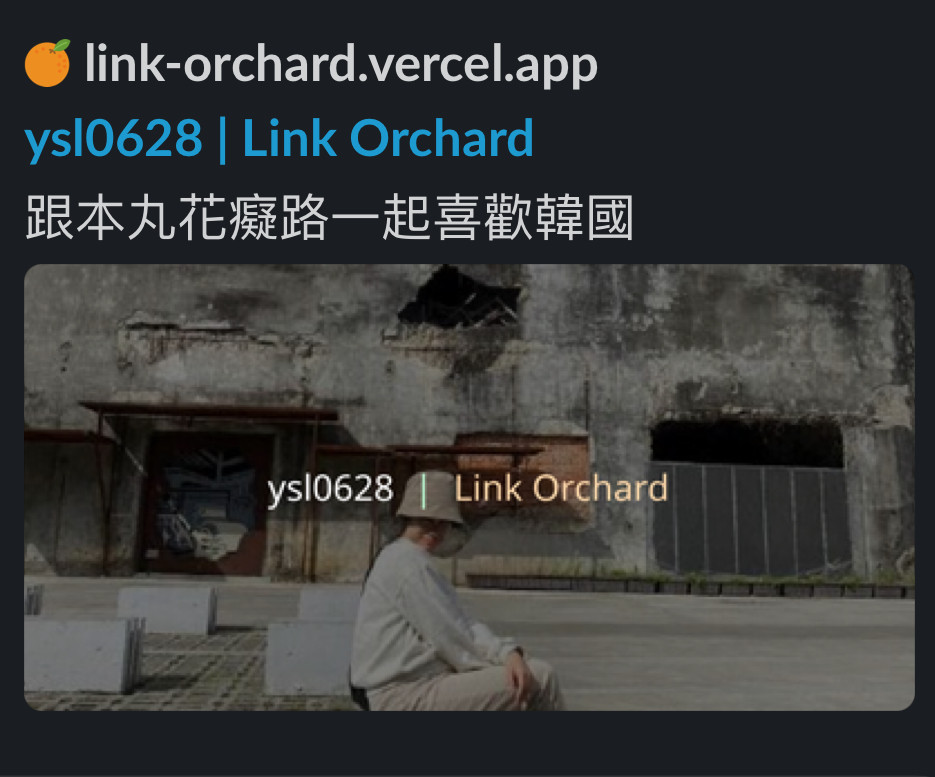SEO,是搜尋引擎最佳化 (Search Engine Optimization) 的簡稱,是一套策略技術,幫助提升網站或網頁在搜尋引擎裡的曝光度。主要的目標是讓網站有更多流量,而這些流量大部分來自搜尋引擎的自然搜尋結果,不是付費或直接點擊連結的流量。SEO 不只是針對網站的文字內容進行優化,還要考慮圖片、影片和其他多媒體。網站的流量來源可以有很多種,例如來自圖片搜尋、影片搜尋、學術文章搜尋或是某個特定產業的搜尋引擎。
Meta tags 是網頁的後台資訊,提供給搜尋引擎對網頁內容的基本描述。設定適當的 Meta tags能幫助搜尋引擎更正確地解讀和索引你的網站,進而提高在搜尋結果中的排名。而 Next.js 的 Metadata API 提供了一個方便的方式來管理和生成 Meta tags。
Next.js 提供的 Metadata API 可以讓開發者更方便的設定各種 meta tags,只需要在 layout.js 或 page.js 檔案中,定義並 export 一個靜態的 metadata 物件或一個動態的 generateMetadata function,就會自動為頁面生成相關的 <head> element。
在本篇文章中,將會介紹一些對 SEO 具影響力的 Meta tags,並且提供相關的範例。
<title>)這是每個網頁裡重要的 meta tag 之一,顯示在搜尋結果的藍色標題連結上。這個標題要簡潔、獨特,且要能夠準確反映該頁面的主要內容。Next.js 中的 Title Tag,不僅可以在 root 上設定,也可以在各個路徑中自訂義,或是以 template 的方式呈現:
建立 metadata 物件後,設定值為靜態 string 的 title 屬性
export const metadata: Metadata = {
title: 'Admin'
}
在 Root layout 檔案 (app/layout.tsx) 中,你可以使用 title.template、title.default 和 title.absolute 來設定 title。

// app/layout.tsx
export const metadata: Metadata = {
title: {
default: 'Link Orchard',
template: '%s | Link Orchard',
}
}
default:在 app/layout.tsx 中設定 default 作為有設定 template 時,但子路徑未定義 title 時的預設 title。
// app/(public)/[username]/layout.tsx
export const metadata: Metadata = {}
// 頁籤標題:Link Orchard
template:可為子路徑定義的標題添加前綴或後綴,變數以 %s 定義,當子路徑設定 title 時會呈現:<子路徑 title> | Link Orchard 。
// app/(portal)/portal/layout.tsx
export const metadata: Metadata = {
title: 'Portal'
}
// 頁籤標題:Portal | Link Orchard
absolute:當 app/layout.tsx 中有設定 template,但不想在當前路徑繼承時,可以使用 absolute 忽略並顯示設定的值。
// app/contact-us/layout.tsx
export const metadata: Metadata = {
title: {
absolute: 'Contact Us'
}
}
// 頁籤標題:Contact Us
<meta name="description" content="...">)這個標籤提供了頁面的簡短摘要,並在搜尋結果中顯示。雖然不會直接影響搜尋排名,但一個吸引人的描述可以提高點擊率。

export const metadata: Metadata = {
title: "Link Orchard",
description:
"Branch Out with LinkOrchard:探索連結的果園,一次點擊就能找到所有你的精彩內容。將你的最佳連結栽種在這片網路果園中,並讓你的追蹤者在其中自由採摘。不只是 link in bio,更是你品牌故事的繽紛果園。",
};
<link rel="canonical" href="...">)當網站出現相似或重複的內容,可能讓搜尋引擎難以判定哪一頁是"標準"版本。Canonical Tag 的功能即是在此情境下指引搜尋引擎,透過在HTML的標籤中加入rel="canonical"屬性,明確標註哪一個URL為首選,確保搜尋引擎能正確理解和索引網頁。
假設 LinkOrchard 的用戶 Renee 有以下連結:
https://linkorchard.com/renee123?ref=homepage
https://linkorchard.com/renee123?campaign=summer
https://linkorchard.com/renee123
儘管這些連結指向相同的頁面,但由於 URL 的 query string 不同,搜尋引擎可能會視它們為不同的頁面。為了確保搜尋引擎知道 Renee 的主要頁面是第三個URL,我們可以在此頁面的 Page.js 中加入的 meta tag,由於各用戶頁面的生成是動態,所以我們使用 generateMetadata 以及 alternates 屬性來實現:
export function generateMetadata({
params,
}: {
params: { id: string },
}): Metadata {
return {
alternates: {
canonical: `https://linkorchard.com/${id}`,
},
};
}
const Page = async ({ params }: { params: { id: string } }) => {};
export default Page;

<meta name="robots" content="...">):這個 tag 能告訴搜尋引擎是否要索引這個頁面或追蹤頁面上的連結。例如,使用 noindex 可以確保搜尋引擎不會索引此頁面,而 nofollow 則讓搜尋引擎知道不應追蹤頁面中的連結。
在我們的專案裡,後台頁面是受保護的,只有登入後才能存取,所以這些頁面一般不會被搜尋引擎索引。為了保障隱私和確保資訊安全,建議使用 noindex 進行設定,這樣可以避免搜尋引擎不小心索引到這些後台內容。
// app/(portal)/portal/layout.tsx
export const metadata: Metadata = {
title: "Portal",
robots: {
index: false, // 告訴搜尋引擎不要索引此頁面,頁面不會出現在搜尋結果中
follow: false, // 告訴搜尋引擎不要追蹤此頁面上的連結,即不進一步查看這些連結
nocache: true, // 告訴搜尋引擎不要將此頁面存儲在其暫存中
},
};
sitemap 是一個能夠列出你網站上所有頁面的清單,主要目的是幫助搜尋引擎更方便地探索和索引你的網站。當你的網站很大或結構複雜時,有了 sitemap,搜尋引擎就能更輕鬆找到所有頁面,確保它們都被正確地索引。而 XML 格式的 sitemap 還可以提供頁面的其他資訊,像是多久更新一次或是哪些頁面比較重要。
當正在評估網站是否需要設置 Sitemap,可參考以下 Google 的建議:
在 Next.js 中可以在 app 根目錄上建立一個 sitemap.js,會自動轉為 XML 檔,其中只需要設定『 公開 』的網站,所以後台頁面不適合出現在設定中。每個連頁面有以下屬性:
new Date() 賦值。always、hourly、daily、weekly、monthly、yearly 或 never。0.0 到 1.0。import { MetadataRoute } from "next";
export default async function sitemap(): MetadataRoute.Sitemap {
const users = await getAllUsers();
const userUrls = users.map((user) => ({
url: `https://linkorchard.com/${user.username}`,
lastModified: user.updatedAt,
changeFrequency: "daily",
priority: 0.7,
}));
return [
{
url: "https://linkorchard.com",
lastModified: new Date(),
changeFrequency: "yearly",
priority: 1,
},
{
url: "https://linkorchard.com/contact-us",
lastModified: new Date(),
changeFrequency: "yearly",
priority: 0.4,
},
{
url: "https://linkorchard.com/privacy-policy",
lastModified: new Date(),
changeFrequency: "never",
priority: 0.2,
},
...userUrls,
];
}
Open Graph Tags 和 Twitter Cards 是幫助我們優化社交媒體分享的 meta tags。Open Graph 是由 Facebook 推出的,當我們分享網站連結到臉書時,它會依照這些設定的標籤來顯示預設的標題、內容描述和圖片,確保分享的外觀既美觀又吸引點擊。而 Twitter Cards 則是 Twitter 的版本,讓我們分享的連結在 Twitter 上呈現為有質感的預覽卡片。透過這些小工具,不僅讓網站在社交平台上的展現更加專業,同時也增加了人們點擊的意願。
而 Next.js 提供開發者在各個路徑資料夾設定 opengraph-image (以下簡稱 og)以及 twitter-image tsx 檔案為專案個頁面設定這項 meta tag,並且藉由 next/server 的 ImageResponse API 以 JSX 及 CSS 生成圖片。
⚠️注意:
ImageResponse API 在 Next.js 14 版本中,為了解決由於大模塊的圖像首先被打包然後被 tree-shaked 導致的 webpack 快取警告(issue #49118),已從原本的 next/server 庫移至 next/og。
⚠ metadata.metadataBase is not set for resolving social open graph or twitter images, using "https://link-orchard-ngov4miow-ysl0628.vercel.app". See https://nextjs.org/docs/app/api-reference/functions/generate-metadata#metadatabase
image:alt,設定 og 及 twitter image 的替代文字image:width 及 image:height
image:type
image 本身,使用 ImageResponse 回傳一個圖檔// app/(public)/(routes)/[id]/
import { ImageResponse } from "next/server";
import { getUserByUsername } from "@/actions/getUserByUsername";
export const size = {
width: 900,
height: 450,
};
export const contentType = "image/png";
export default async function Image({ params }: { params: { id: string } }) {
const user = await getUserByUsername(params.id);
return new ImageResponse(
(
<div tw="relative flex items-center justify-center">
<img
src={user?.customImage || '/images/placeholder.jpg'}
alt={user?.title || 'cover'}
tw="object-cover"
/>
<div tw="absolute flex bg-black opacity-50 inset-0 " />
<div tw="absolute flex items-center top-2 w-full ">
<p tw="text-white text-4xl flex font-bold m-5">{user?.title}</p>
<p tw="text-indigo-200 text-xl flex font-bold m-5">
{user?.username}
</p>
<p tw="text-purple-200 text-xl flex font-bold m-5">
{user?.updatedAt?.toDateString()}
</p>
</div>
</div>
),
size
);
}

http://localhost:3000/ysl0628/opengraph-image-2s6j21?b898c4e5c88b729f 的圖片內容:

分享的成果:


SEO 是一個持續優化的過程,並且需要多方面的技巧與策略。使用 Next.js 和相關的工具,我們可以更簡單地管理和優化網站的 SEO,讓我們的網站在搜尋引擎結果中取得更好的排名。適當的 meta tags、sitemap 和社交分享標籤都是提高網站流量的關鍵元素。透過不斷的學習和嘗試,我們可以使我們的網站更容易被搜尋引擎和用戶找到。
相關程式碼同步於:
https://github.com/ysl0628/2023-ithelp/tree/main/day-27
https://github.com/ysl0628/next13-omni-links/blob/main/app/(public)/(routes)/%5Bid%5D/opengraph-image.tsx
https://zh.wikipedia.org/zh-tw/搜尋引擎最佳化
https://www.youtube.com/watch?v=L8_98i_bMMA
https://youtu.be/kFzXOuBFN9Q?si=zzm3nKqShpQLS0zb
https://welly.tw/serp-rank-optimization/what-is-canonical-url
https://github.com/vahid-nejad/nextjs13-seo/blob/main/src/app/post/%5Bslug%5D/opengraph-image.tsx

